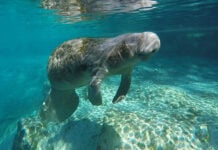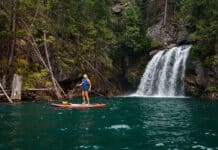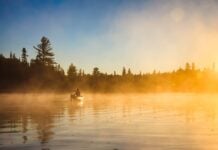Making a shortlist of Algonquin Park’s finest lakes is no easy task. With more than 1,500 lakes to choose from, there are hundreds of breathtaking destinations that offer something for everyone. To create this list of 21 lakes, we factored in each lake’s exceptional scenic value, as well as its ease of access for paddlers and hikers, and what else you can see in the surrounding area. We also selected lakes with above-average campsites, so you can spend as much time soaking up those lakefront views as you like.
[This article is part of our Ultimate Algonquin Park Travel Guide. Find all the resources you need to plan an adventure-filled trip to Algonquin Park.]
Best lakes in Algonquin
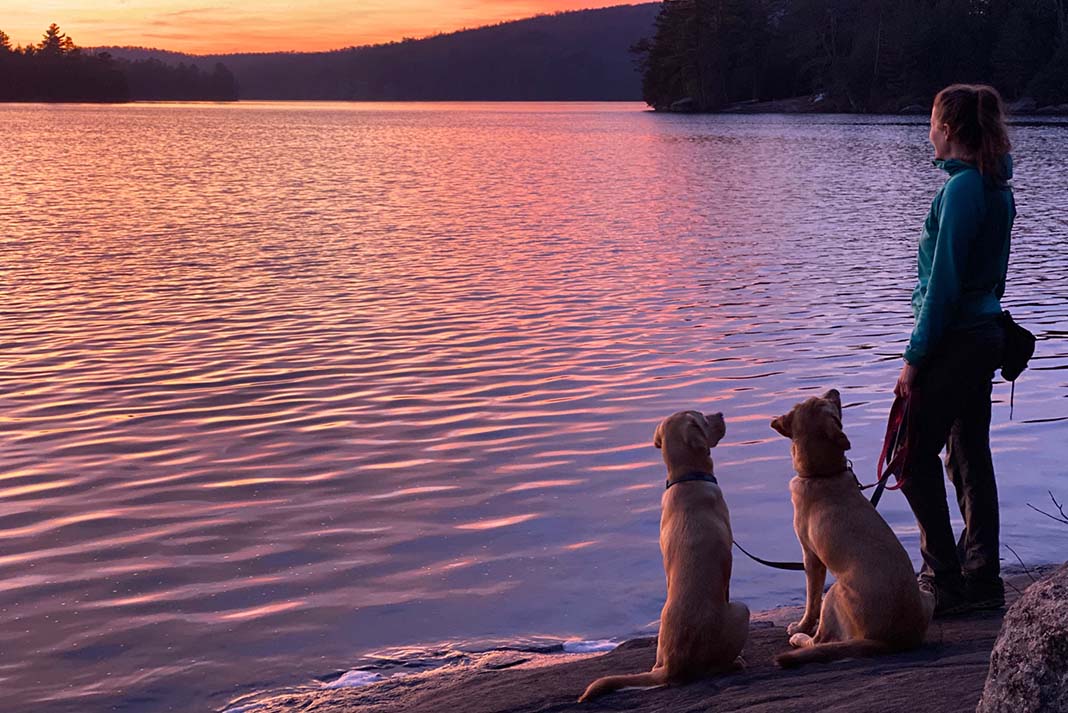
Rock Lake
Rock Lake has all of the ingredients for a perfect paddle-hike-camp destination. You could paddle around it in a single day, but there’s so much to see that you’ll want to linger longer. Stay at Rock Lake Campground or one of the 18 backcountry campsites scattered around the lake’s southeastern shore and central islands. Choose your view: dramatic cliffs, spectacular sunset or serene bay—there’s a site to suit every taste. Return to the water to search for ancient Indigenous pictographs, try your best yodel in Echo Bay or park your canoe at the trailhead for Booth’s Rock—an easy 5-km hike with a jaw-dropping view of Rock Lake.
View this post on Instagram
Lake of Two Rivers
The panorama that unfolds as Highway 60 twists and turns around Lake of Two Rivers is a highlight of any fall-colours drive in Algonquin Park. Fortunately it’s easy to see more of this lovely lake than the fleeting glimpses from the highway. Book a campsite at Lake of Two Rivers Campground, and bring (or rent) all the toys: paddle at dawn to witness superlative sunrise views, then hike or pedal along the lake’s south side on the Old Railway Bike Trail.
Pog Lake
The beauty of Pog Lake lies in this small lake’s quiet bays and superb accessibility. Pog Lake Campground encompasses much of the shoreline, with plenty of well-spaced lakeside campsites nestled in majestic pine forest. For such a petite lake, there’s lots to do once you’re here: two swimming beaches, easy access to the Old Railway Bike Trail and peaceful canoeing along the Madawaska River to Lake of Two Rivers or Whitefish and Rock lakes.
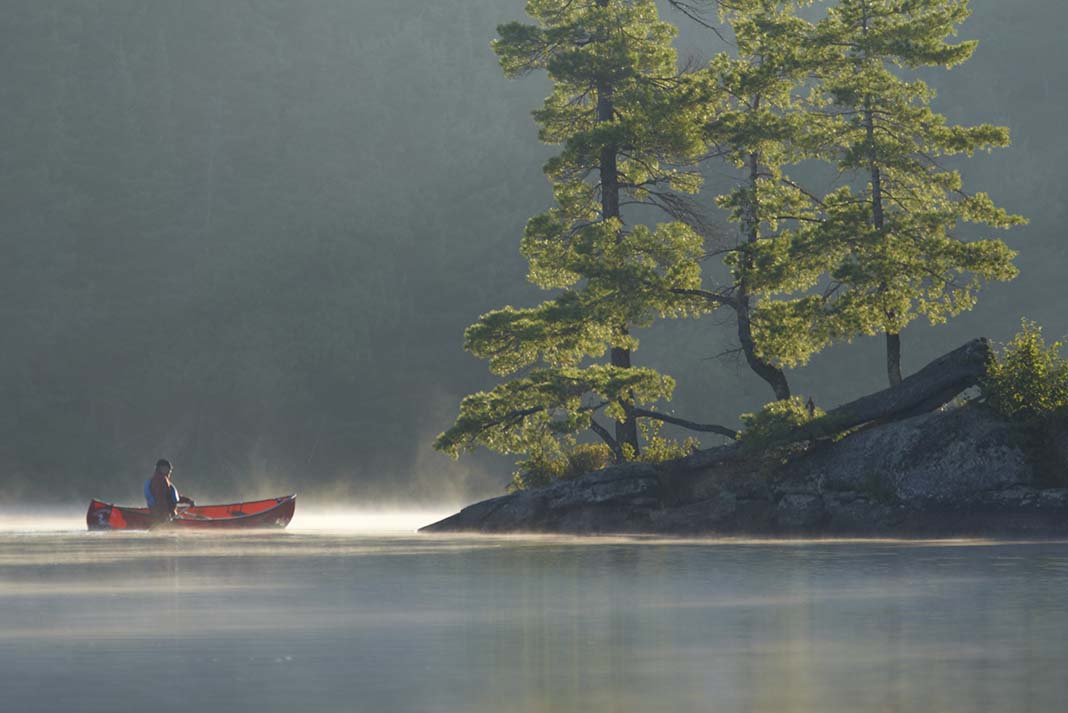
Mew Lake
For an intimate lake experience with the convenience of being steps from your comfy vehicle campsite, Mew Lake is a great option. Cradled by the white pines of Mew Lake Campground, this small lake sees little traffic aside from the occasional forays of your fellow campers.
Lake Opeongo
Look at a map of Algonquin Park and it’s impossible to miss Lake Opeongo. Sprawling across the heart of the park, Opeongo is the largest of Algonquin’s more than 1,500 lakes and undeniably one of its most beautiful.
These are vast waters—there’s plenty of diverse shoreline here for a week or more of canoe or kayak tripping. With over 130 backcountry campsites to choose from, finding privacy and solitude is as simple as paddling around the next point. Historical remnants, hidden islands and wildlife-filled wetlands invite exploration.
Cedar Lake
Accessed by a 40-km gravel road from the north side of Algonquin Park, Cedar Lake receives far fewer visitors than the lakes found along the Highway 60 corridor. This is a large lake with lots to see, so base yourself at Brent Campground or one the widely scattered backcountry sites. Paddle into one of the lake’s two provincially significant marshes to spot moose and other wildlife, then search the shoreline for artefacts from the park’s pioneer era.
View this post on Instagram
Grand Lake
It’s no surprise that at times canoeing on Grand Lake feels more like paddling in a wide river valley than on a lake. This long, narrow lake occupies a natural fracture in Algonquin’s bedrock landscape and forms part of the headwaters of the Barron River, which enters its own spectacular canyon just a few kilometres downstream of the lake. Look for unique glacial remnants, Indigenous pictographs and secluded campsites along the lakeshore. South of the developed sites at Achray Campground, the undulating hills of Carcajou Bay form the backdrop to the iconic Tom Thomson painting, “The Jack Pine.”
View this post on Instagram
Galeairy Lake
Galeairy Lake is an access point to the interior of Algonquin Park’s southern panhandle, but this sizeable lake is also a beautiful destination in its own right. Many of the interior campsites here perch on high rocky points, giving lovely lake and sunset views. History buffs can explore Farm Bay for the remains of an amphibious boat called an “alligator”—used for hauling logs across both land and water.
Big Trout Lake
The heart of central Algonquin Park is an area of mid- to large-sized wilderness lakes interconnected by centuries-old portage trails and meandering waterways. Big Trout Lake anchors the west side of a terrific weeklong canoe tripping circuit from Lake Opeongo. The only other visitors you’ll see on this remote, island-studded lake are adventurous trippers like yourself. If you like island campsites, you’ll love Big Trout Lake.
View this post on Instagram
Little Trout Lake
On the west side of Algonquin Park, Little Trout Lake makes an enticing stopover for canoe trips starting out at the Magnetawan Lake access point. At just two kilometres long, this pine-rimmed lake has an intimate feel and 11 fine backcountry campsites to choose from.
View this post on Instagram
Little Eagle Lake
For seclusion-seekers, it’s hard to beat Little Eagle Lake. This small, isolated lake on the west side of Algonquin Park has a solitary campsite situated on a west-facing point—perfect for private sunsets (and skinny-dipping). Even better, you won’t have any unexpected visitors—the only way into and out of the lake is via a 340-metre portage.
North Tea Lake
In the northwest corner of Algonquin Park, North Tea Lake boasts a rare combination of breathtaking sandy beaches, loads of portage-free paddling and picturesque islands, and tons of gorgeous backcountry campsites. With two distinct arms and nearly 70 campsites to choose from, it’s possible to find privacy and seclusion even on busy summer weekends. Enjoy stunning sunsets and swimming, and watch for wildlife at the Amable du Fond River—this winding waterway is a moose hotspot.
View this post on Instagram
Burntroot Lake
Lying in the heart of the Algonquin backcountry, Burntroot Lake takes several days’ travel by paddle and portage to reach. But its isolation is what makes this large, island-studded lake so special. All 25 campsites on Burntroot remind paddlers why Algonquin Park backcountry camping is world-renowned. And, if you’re a fan of pitching your tent offshore, this lake has no fewer than 11 island campsites. Explore the varied shoreline for artefacts of Algonquin’s early homesteading, farming and logging eras.
Canisbay Lake
Lovely Canisbay Lake offers some of Algonquin Park’s most secluded developed camping at Canisbay Lake Campground, as well as easy access to 16 backcountry campsites for novice paddlers and campers. In the fall, the surrounding hardwood forest explodes into a riot of colour and canoeists can forage for wild cranberries at the lake’s southern outlet.
View this post on Instagram
Big Crow Lake
Travelling north by canoe from Lake Opeongo, you could paddle right through Big Crow Lake on your way to the area’s larger lakes, but you would be missing out. Instead, pitch your tent at one of Big Crow Lake’s 10 backcountry campsites or, for a truly unique Algonquin experience, rent the restored fire ranger cabin on the lake’s south arm. Hike up the short trail behind the cabin to the old fire tower and enjoy a spectacular lake view from atop these cliffs. Nearby, another trail leads into a remnant of majestic, old growth white pine forest.
View this post on Instagram
Harness Lake
The beauty of Harness Lake lies not only in its quiet seclusion and rock point campsites, but also in the variety of ways you can visit the lake. Paddle and portage south from Cache Lake access point, or trek the long loop (35 kilometres) of Algonquin’s Highland Backpacking Trail. Either way, you’ll love the tranquility of this small highland lake.
View this post on Instagram
Lake Louisa
Even if you don’t subscribe to the notion that a bit of sweat makes your backcountry campsite all the sweeter, Lake Louisa’s stunning natural beauty and isolation makes it worth the effort to get here. Before you can settle into one of the 23 campsites perched amid the lake’s windswept pines and panoramic rock points, you’ll need to carry canoes and packs 3,000 metres across the portage from Rock Lake. In spring, Lake Louisa rarely disappoints anglers—lunker lake trout in these clean, clear waters grow to 55 cm (22 inches).
Shall Lake
Shall Lake is one of the less visited Algonquin Park access points on the south side of the park, making this small lake ideal for a quiet yet accessible day trip or overnight. From Shall Lake, paddlers can visit the equally peaceful Farm and Crotch lakes without needing to portage. All three lakes offer inviting interior campsites, as well as rewarding fishing for northern pike, smallmouth bass and, in spring, lake trout.
Booth Lake
Regarded as one of the most picturesque Algonquin Park interior lakes, Booth Lake boasts 18 beautiful campsites strategically scattered around the lake on beaches, islands and rock points. Diverse fish species await anglers, while paddling photographers enjoy a visual feast that includes spectacular fall colours and abundant moose in the extensive wetland complex around McCarthy Creek.
Rosebary Lake
In late September and early October, the hardwood forest hillsides cradling Rosebary Lake are ablaze with breathtaking fall colour. Situated on the west side of Algonquin Park, the lake has fewer visitors than routes accessible from Highway 60—late-season campers may find they have Rosebary’s six backcountry campsites all to themselves. Choose a site with southeast exposure for early morning sunshine to warm up after a chilly night, or pick one of the lake’s west-facing points for stunning sunsets.
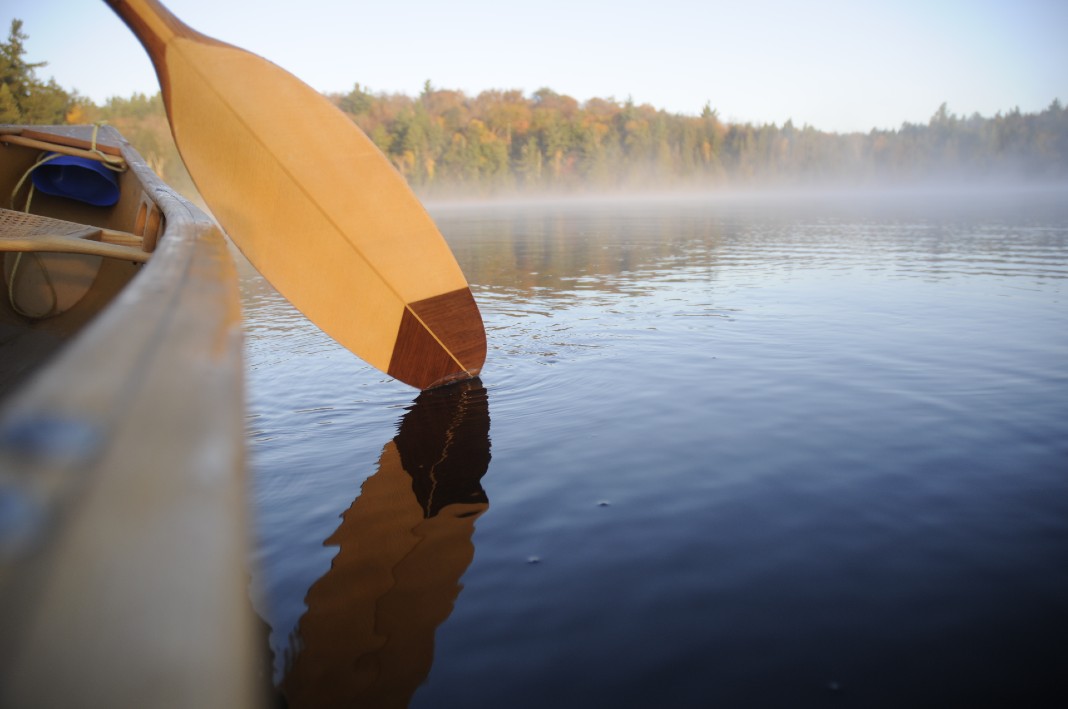
Nadine Lake
Perched in a copse of hardwoods, far off the beaten track in Algonquin Park’s central highlands, Nadine Lake is known as a green headwater lake. Unlike the familiar “root beer” tint of most of the park’s rivers and lakes, which results from staining by tree tannins, Nadine Lake’s crystal clear, chilly waters are spring-fed. Accessed via a 1,400-metre portage from the Nipissing River, there are four backcountry campsites on this remote Algonquin Park lake.
Algonquin lakes and routes maps
Purchase the official Canoe Routes Map or Backpacking Trails Map from The Friends of Algonquin Park. For even more maps of the park, visit Don’t Get Lost In The Woods: A Guide To Algonquin Park Maps.
Paddle the most beautiful lakes in Algonquin Park. | Feature photo: Courtesy Destination Ontario


